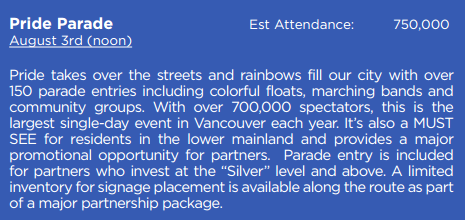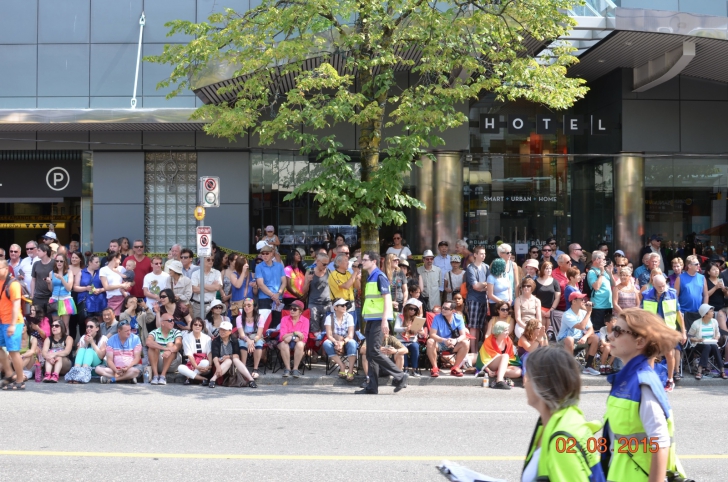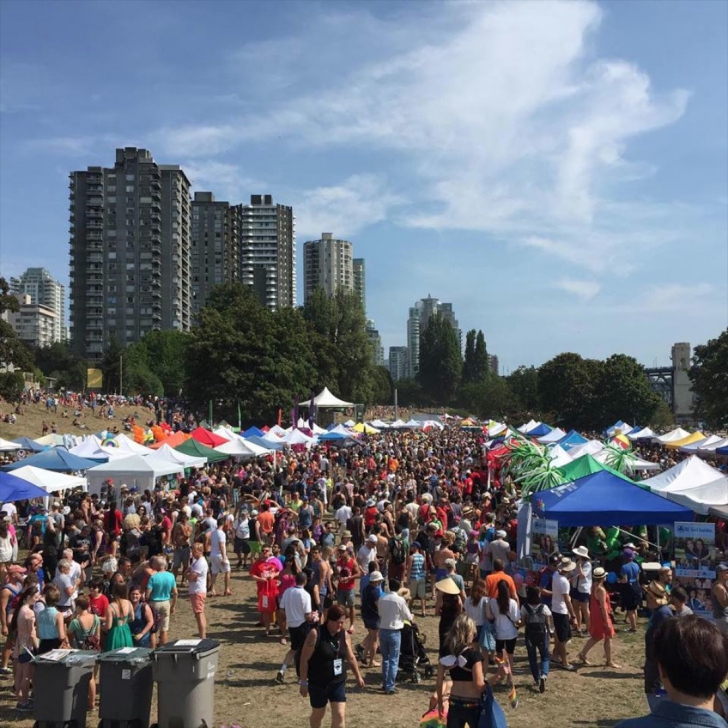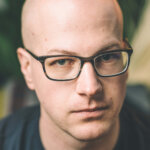No, there were not 650,000 people at Vancouver’s 2015 Pride parade. Not even close.
The Vancouver Pride Society (VPS) has quoted that mind-boggling figure for years as the size of the crowd at the yearly parade. In turn, the number has been parroted by the Vancouver Sun, the Globe and Mail, the CBC, and even Daily Xtra. The myth even spread to federal politics, where Liberal leader Justin Trudeau said he promised to join “the half-a-million British Columbians who will be celebrating Pride this afternoon.”
An investigation by Daily Xtra, however, has shown the society’s numbers are not only vastly exaggerated, but have never been based on a reliable count of the crowd.
Daily Xtra estimates that fewer than 100,000 people, a small fraction of the society’s claim, attended the 2015 parade, held Sunday, Aug 2. In response to our report, VPS executive director Ray Lam says the organization will stop claiming a number of attendees until a professional count can be conducted.
The VPS has claimed 650,000 attendees since at least 2011, when organizers told the Toronto Sun they expected the largest crowd ever at the parade, larger than the last estimated number of 600,000. In 2012, organizers told 24 Hours they had set a “ballpark figure” between 600,000 and 650,000 attendees, and by 2013 the 650,000 number appeared in publications from the Vancouver Sun to the Huffington Post.
In 2015, the VPS proudly proclaimed on its website that the Pride parade attracts “crowds of more than 650,000” and literature the society provided to advertisers boasted 750,000 people.

(Information from the Vancouver Pride Society’s “Partnership Package” aimed at advertisers.)
To test these claims, Daily Xtra sent a photographer to the 2015 parade, taking hundreds of photographs of the crowd.
Using the photographs, Daily Xtra estimated the number of people lining each metre of sidewalk along the parade route, making additional allowances for spectators in buildings, crowd movement and those waiting at the Pride festival grounds at Sunset Beach.
Daily Xtra also consulted with crowd-counting expert Paul Yip, who developed crowd-counting models to estimate crowds in Hong Kong’s anti-government protests. Both Daily Xtra’s and Yip’s models agree that approximately 80,000 people attended this year’s Pride parade in Vancouver, about an eighth of the society’s estimate.
(You can read a detailed explanation of Daily Xtra’s methodology here.)

(The crowd on Robson Street as the Vancouver Pride parade began on Aug 2, 2015./Niko Bell photo)
***
To get an idea of just how inflated the 650,000 attendance figure is, try doing a little arithmetic. The Vancouver Pride parade route is about four kilometres long, including the staging zones surrounding Robson Street and the actual parade route that runs west down Robson Street and south along Denman Street and Pacific Street, where it concludes near Sunset Beach.
The streets are at most 25 metres across, from building to building. Experts in crowd counting say that a crowd of “mosh pit” density fits about four people per square metre, about the size of a hula hoop. That means if the entire parade route were one solid seething mosh pit, from building to building, all the way from beginning to end, the crowd would still only reach 400,000 people.

(This is not a picture of a wall-to-wall mosh pit./Niko Bell photo)
To visualize it another way, look at the photograph below, showing one of the busiest areas of the 2015 Pride parade route near the Blue Horizon Hotel on Robson Street.
There are about 110 people visible in the photograph. For the crowd to number 650,000 people total, there would have to be more than 800 people crammed into that spot — more than seven times what we see in the photograph.

(Imagine a crowd seven times this large, standing on the same sidewalk./Niko Bell photo)
This is not the first time someone has noticed the discrepancy. In 2012, Daily Xtra reported that the Vancouver Pride numbers seemed puzzlingly unfounded. In 2013, Huffington Post blogger Mark Hasiuk did some quick math and realized the count made no sense. Criticism, however, was insufficient to stop the figure from spreading.
If the 650,000 figure is so catastrophically wrong, how did anyone ever come up with it? Many of the details were reportedly worked out in informal meetings between VPS coordinators and the Vancouver Police Department’s Operational Planning Unit and, unfortunately, never committed to paper.
However, according to former VPS presidents Shawn Ewing and John Boychuk, the VPS was told sometime around 2002 to start providing attendance numbers to determine insurance coverage and required staffing levels for police officers assigned to parade crowd control. Boychuk says that after each Pride parade, the VPS would meet unofficially with police to get a ballpark number for the parade. Often, the police would simply estimate whether the parade seemed larger than last year (it always did), and the VPS would write in a new number accordingly.
“It’s not as scientific as some people would like,” Boychuk says. “We didn’t really have a system for figuring it out. It’s more of a guesstimate than anything.”
“We leaned very heavily on the police,” Ewing says. “They would call up at the end of the parade and give us a quick debrief. There was no great science to it. We had to have factual evidence, so we all wrote it down so we were all saying the same number.”

(For reference, approximately 400 people are visible in this photograph of the post-parade Pride Festival at Sunset Beach, posted Aug 2, 2015 to Instagram by VPS president Tim Richards.)
Gradually, the estimate crept higher. By 2005, VPS documents show its board of directors believed the parade had grown to 160,000 attendees. By 2006, the number had doubled to 300,000. Year by year the numbers floated upwards, until they were rounded up to half a million by 2008, and then 650,000 by 2011. In that time, no methodical study of the parade was ever done.
At some point, nobody remembers when, the Vancouver Police Department stopped supplying crowd estimates altogether, but the numbers continued to be passed around from document to document, without verification.
For example, when Daily Xtra approached the City of Vancouver to find out how the decision was made to grant the parade civic status in 2013, the city pointed us to a report written by the committee on Planning, Transportation and Environment that quoted the number as half a million. The report based its numbers on an economic impact study performed by the Vancouver Tourism Bureau. The Bureau, however, denied ever having written such a study, and suggested it must instead have been written by the VPS.
When Daily Xtra looked at the study, written for the VPS by WestQuest Consulting in 2001, it turned out to have simply quoted the Vancouver police (who had said 100,000 at the time).
And therein lies the real problem. Canadian police officers, contrary to popular assumption, have little specialized training in counting crowds. As a Victoria police officer explained to a journalist after a similar mix-up over crowds at a protest, “Our job is not to count, but to escort and protect people.”
When Daily Xtra asked the Vancouver Police Department for any information on how it counts crowds, media liaison Constable Brian Montague explained that it isn’t very important to the police exactly how many people are at an event. How many officers are needed at the scene has more to do with how many incidents occur, he says, than how many people are present. The department stopped giving out estimates because they were difficult to perform accurately, and were more trouble than they were worth.
“There are times we would have the same number of officers at an event with 1,000 people as we would with 60,000,” Montague says. “Crowd estimation after an event is more for the curiosity of the public and the media.”
Reports of the number of people at the Vancouver Pride parade, in other words, have always been estimations based on rough calculations based on guesses by people who lacked the motive or resources to know the answer in the first place.
***
Not that getting the size of a crowd wrong should be at all surprising.
The art of crowd estimation has always, say crowd-counting researchers Paul Yip and Ray Watson, been notoriously poorly executed. In their research, for example, they look at Hong Kong protests in which organizers claimed 150,000 attendees. Yip and Watson calculated something closer to 80,000. At Glenn Beck’s “Restoring Honor” rally at the Lincoln Memorial in Washington, DC in 2010, Beck estimated up to 650,000 people. Scientists using weather balloons and high-tech mapping software counted 87,000.
Nor should it be surprising that a Canadian Pride parade inflate its numbers. Pride Toronto claimed 1.2 million attendees at its Pride festival in 2013, when in fact there may have been 400,000.
A 2009 economic impact report had said there were 1.2 million visits to the Toronto festival, even if the same guest visited more than one Pride event. Someone who attended the Pride parade, hung out at the Church Street block party then went into a bar, for example, may have been counted three times. The numbers were quickly misrepresented by the city and misconstrued by the media, and the myth of a million people at Toronto Pride was born.
***
Counting crowds is not just a mathematical game, however; it means money.
The Vancouver Pride parade receives funding based on its numbers in two ways. First, it sells advertising based on how many eyeballs are in attendance to see it. This year, the VPS offered its advertisers at the parade 750,000 pairs of eyeballs — a promise upon which it did not deliver.
Second, the VPS pulls in higher discounts on services from the City of Vancouver based on its numbers. In 2013, when the city inducted Pride as a civic parade, it created a special category for parades with attendance over 400,000 people, for which only Pride supposedly qualifies. In 2014, the VPS pulled in $39,000 in offset grants based on those qualifications.
After looking over Daily Xtra’s study, VPS president Tim Richards says he doesn’t think Pride should get any less money.
“I think our partners think it’s important to support who we are, what we stand for, what we’re doing in the Pride parade,” he says. “I think that’s why they buy space in the Pride guide, or participate in the parade. I don’t think it’s because of just one number.”
While VPS executive director Ray Lam initially agreed to stop using the 650,000 figure until further study, Richards isn’t so sure. “I can’t give a definite answer,” he said, after Daily Xtra asked him several times about using the number in VPS materials. Richards says the VPS doesn’t have enough money to properly study the problem for now.
“I think it’s important to stress that while numbers are interesting and numbers are important — I love numbers and I’m a numbers guy — this is about the values that bring us together as a community,” he says. “I think that’s what our partners and that’s what the city are buying into when they support us.”
Next year, Richards says, he looks forward to welcoming back “tens of thousands, or hundreds of thousands of people” to attend Pride. How many tens or hundreds of thousands remains a question.


 Why you can trust Xtra
Why you can trust Xtra


